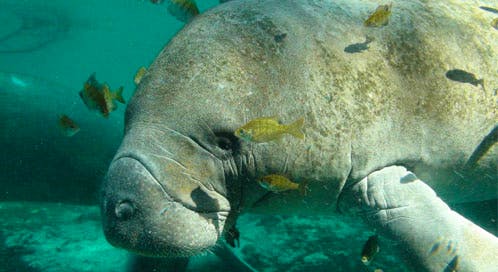Last month, the U.S. Fish and Wildlife Service announced that it would consider downlisting one of our nation’s most beloved endangered species: the Florida manatee.
These vulnerable marine mammals were originally listed as endangered way back in 1967, when USFWS determined that habitat loss and watercraft collisions were putting them on the road to extinction. Protection and careful management have helped this species move toward recovery instead, and today manatee-watching supports a thriving tourism industry in the state.
The Service is under pressure from boaters, marine contractors, private-property rights advocates and other special interests to reclassify the manatee as “threatened” in the hopes of rolling back protections, such as slower speed zones. These and other protective measures have been instrumental in helping the manatee population to improve over the years, and will continue to be necessary to sustain the population going forward.

Nevertheless, it’s a good thing that USFWS is reviewing the manatee’s status and using the most current information on the population to make decisions about future management. In fact, the five-year review of this endangered species is long overdue. Manatees’ future in the wild is far from secure as they still face many challenges:
- Many of the natural springs manatees use for refuge from the cold in winter have been lost to development. Manatees are drawn to the warm water released by power plants like the one at Cape Canaveral, but if these plants close down, approximately 60% of the population would lose vital protection from chilling winter waters. More than 700 manatees died in 2010 when there was a prolonged period of extremely cold weather.
- Much of the sea grass beds that manatees depend on as a major food source have also been lost or degraded, due to propeller and anchor damage, dredging and runoff from coastal development and agriculture, which cause silt and algae to block the sunlight sea grass needs to survive.
- Toxic algal blooms called red tides can sicken and kill manatees (as well as dolphins, birds, sea turtles, fish, and other animals). In 2013, unprecedented harmful algal blooms on both coasts of Florida led to a record number of deaths – over 800 manatees in a single year.
- Finally, collisions with watercraft are the leading threat to Florida manatees. If not killed outright when hit by these vehicles, manatees may die from infection, blood loss or other complications from their injuries later on. Those that survive often bear large scars from their encounters with boat hulls and propellers. This is why slow speed zones for boaters are essential to help Florida manatees survive: they give manatees a chance to get out of the way, and give boaters a chance to spot and avoid them.
 It’s hard to see why USFWS would consider downlisting the manatee, especially after such alarming manatee die-offs in 2010 and 2013, which together claimed the lives of nearly 1,600 manatees. However, a thorough, science-based status review should give officials more information on how these endangered manatees are doing. In Florida, Defenders has fought hard for decades to ensure that protections for manatees are strong and effective. We work to get protective slow speed zones put in place in areas where manatees are often found, secure their habitat, and educate the public on safe boating and manatee-watching practices. As the USFWS undertakes its review process, we’ll monitor to ensure they use the best and most current information. But no matter what, protections for the manatee need to stay in place to ensure a healthy and robust manatee population for future generations to enjoy.
It’s hard to see why USFWS would consider downlisting the manatee, especially after such alarming manatee die-offs in 2010 and 2013, which together claimed the lives of nearly 1,600 manatees. However, a thorough, science-based status review should give officials more information on how these endangered manatees are doing. In Florida, Defenders has fought hard for decades to ensure that protections for manatees are strong and effective. We work to get protective slow speed zones put in place in areas where manatees are often found, secure their habitat, and educate the public on safe boating and manatee-watching practices. As the USFWS undertakes its review process, we’ll monitor to ensure they use the best and most current information. But no matter what, protections for the manatee need to stay in place to ensure a healthy and robust manatee population for future generations to enjoy.
Haley McKey is a Communications Associate at Defenders of Wildlife
Tell USFWS to maintain protections for Florida manatees



